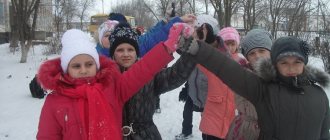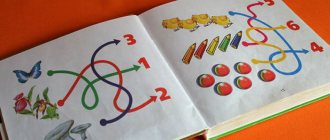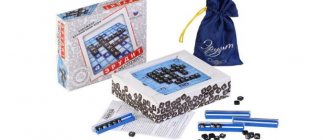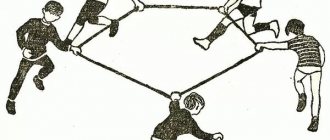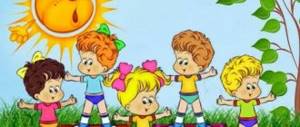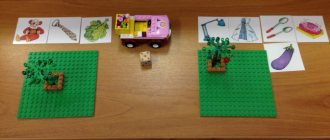CARD FILE: “FOLK GAMES AND FUN FOR CHILDREN.”
The repertoire of summer children's games always includes competition games with a ball.
Flip flops
The players stand in a circle facing the center at a distance of about a step from each other. The driver is chosen according to a counting rhyme. He goes to the center of the circle, calls one of the children by name and throws the ball on the ground so that it bounces in the right direction. The one whose name the driver called catches the ball and hits it with his palm. The number of ball hits is set by agreement, but not more than five, so that the rest of the players do not have to wait long for their turn. After hitting the ball, the player throws it to the driver, and the game continues until someone drops the ball. In this case, the game starts over. The one who dropped the ball takes the place of the driver.
Instructions for playing: play the game on a flat surface so that the ball bounces well. It's better to take a medium-sized ball. No more than 10-15 people take part in this game. The success of the game depends on how well the children control the ball. There is only one rule: you need to hit the ball while standing in one place. The game can be complicated - use 2 or 3 balls, but in this case you need to choose two or three drivers.
Gawker
The participants of the game stand in a circle at a distance of one step from each other and begin to throw the ball, calling by name the person who must catch it. The ball is thrown around until one of the players drops it. The one who dropped it stands in the center of the circle and, according to the instructions of the players, performs 1-2 exercises with the ball. You can take forfeits from the guilty ones, and when playing, offer to perform exercises with the ball: throw the ball high and, when it bounces off the ground, catch it; after throwing the ball up, clap your hands several times and catch the ball, etc.
Instructions for implementation: the game is interesting for preschool children, you can also play with kids. The younger the children, the smaller the number of participants. The ball can be taken of any size depending on the children’s skills; The smaller the ball, the more difficult it is to catch it and perform exercises.
The rules should be remembered: the ball is allowed to be thrown to each other only through the center of the circle; If a player drops the ball while doing exercises, he is given an additional task.
Pillars
The players stand in a circle and throw the ball to each other. You need to beat it off with your palms. Each player carefully watches how the others hit the ball. As soon as the unsuccessfully hit or unsuccessfully caught ball falls to the ground, everyone scatters in different directions. The player who dropped the ball is considered to be driving. He must pick up the ball as quickly as possible and shout: “Fire!” All players stop. The driver must win back - throw the ball at the player closest to him. If he hits, he wins back, he stands in the circle again, the game continues until a new driver appears. If the driver throws the ball at the player and misses, then he is placed on a “table”: he must stand still and not move. When the next moment for running comes, the “pillar” stands still. As a rule, it is at this point that the new driver will throw the ball. If the throw is successful, he wins back, and the “pillar” still remains in place. If the driver misses, then he himself is placed in a “pillar”, and the one at whom he threw the ball returns to the circle.
Ancient sports folk games. fun facts
This is interesting…
"Vintage sports
folk games".
Dudko Natalya Alekseevna
Russia is a sports country. We mastered dozens of sports in a short time, gaining worldwide fame. But at the same time, they forgot their original games, which were played by many generations of our ancestors.
Towns.
Russian version of golf. If we were more zealous about our heritage, then perhaps today Russian businessmen would discuss their deals not on the golf course, but over a game of gorodki. The point of this game is to throw a wooden bat at target figures (made up of wooden posts - “towns”) beyond the line of the playing field - “cities”.
It is difficult to determine the exact date of the appearance of the towns. Mention of “chushka,” as this game was also called, can be found in fairy tales, ancient legends, and the annals of Ancient Rus'. Recognized masters of the towns were Peter I, Alexander Suvorov, Vladimir Lenin and Joseph Stalin. By the way, in the USSR, towns were a real cult: it was rare that a stadium or enterprise did not have its own town site.
Today the towns are the lot of dedicated enthusiasts, but who knows what will happen in five years. After all, all it takes is the Russian president, instead of a badminton racket or alpine skiing, to appear a couple of times with a city bat in his hands, and after a while the towns will regain their cult status.
Lapta.
Lapta is the Russian version of American baseball or English cricket. Although, maybe they are a version of lapta. After all, Russians played it even before the adoption of Christianity. It is curious that the Vikings, who often visited relatives in Rus', adopted the game and tried to cultivate it in Norway. Equipment for playing lapta - wooden bats and felt balls - were found at excavations in Veliky Novgorod dating back to the 14th century. Not a single holiday in Rus' was complete without playing lapta, along with fist fights. Peter I also played lapta, as did the soldiers and officers of the Preobrazhensky and Semenovsky regiments.
Russian writer Alexander Kuprin, a fan of lapta, wrote: “This folk game is one of the most interesting and useful games. Lapta requires resourcefulness, deep breathing, attentiveness, resourcefulness, fast running, a keen eye, firmness of a hand strike and eternal confidence that you will not be defeated. There is no place for cowards and lazy people in this game. I heartily recommend this native Russian game..."
Lapta is played on a flat area approximately 30 by 70 m. two teams of 5-12 people. One team is considered to be “hitting”, the other is considered to be “driving”. After successfully hitting the ball with the bat, the player of the hitting team tries to run to the end of the field, where “home” is located, and then return back. Each player who makes such a successful run earns the team one point. If he is hit with the ball, then the kicking team goes to the field.
Chizh.
Chizh is not as famous as gorodki and lapta, but this in no way detracts from the entertainment value of this sport. The game resembles lapta.
In order to play this game, you will need a “siskin” - a round stick 10-15 cm long and 2-3 cm in diameter, pointed at both ends, as well as a lapta - a board 60-80 cm long, one end of which is hewn, to make it more comfortable to hold in your hand.
A square of 0.5-1.0 m is drawn on the site (the larger the site, the larger the square). A “siskin” is placed in the middle of the square (house). One player is the hitter, the rest are catchers, who move to the edge of the court and stand in a chain one at a time, having agreed who will catch the “siskin” after whom.
The striker hits the end of the siskin with the edge of the bast shoe, makes it fly into the air, and with a second blow tries to knock it further into the field. The catcher tries to catch the "siskin". If he succeeds, then he receives one point and the right to be the striker, and the former striker becomes the last one in the chain. If the catcher does not catch the “siskin,” then he must throw the “siskin” into the house from the place where it fell, and the striker beats it off with a bast shoe. If the catcher throws the “siskin” into the house, he gets one point, if not, then the striker again hits the “siskin” and returns it into the field, and the catcher catches it again.
Horses.
Konyashki is an ancient Slavic version of polo. Only the roles of the horses are played by people, the clubs are replaced by hands, and the balls are replaced by other “riders”. Players are divided into two “troops”. Each “army,” in turn, consists of “riders” and “horses.” The riders were usually girls who climbed onto the backs of boys. The players' task is simple - to unbalance the other pair. The couple that stays on their feet the longest wins. There are no official competitions, but anything is possible in the future.
Bouncers.
Most people are probably familiar with this game. Who among us as a child did not catch candles and deftly jump over the ball? In fact, this fun has been known in Rus' since the time of the first Rurikovichs. It originated in military squads, and then spread to the people until it became a favorite children's entertainment. It's funny that the American counterpart was dodgeball, a very fashionable sport. There is even a Dodgeball Federation in Russia that participates in international competitions. Therefore, in a couple of decades, perhaps Olympic champions will appear here too.
Tatar equestrian competitions
“Horses” (Bayge)
Competition between riders over straight distances and in a circle. 2 or more riders can participate. You need to ride your horse first to the finish line.
“Sleds” (Zhigelep bergә)
Race competition on paired horse-drawn teams.
“Under the saddle” (Mich tobe iyar)
Fast riding, when the rider stays under the body of the horse.
“Cut the apple” (Chabu alma)
It is necessary to chop an apple impaled on a rod at a gallop.
“Scarf” (Shәl)
The guy-rider must bend down at full gallop and pick up the woman’s scarf from the ground, while remaining in the saddle.
“Catch up and kiss” (Kyz kuu)
Grooms' competition. The guy-rider must catch up with the girl-rider and kiss her while galloping.
Tatar children's games
“Running on the trail” (Ezennan baru)
The players are divided into; two teams and line up in two columns behind the starting line. For each team, continuous straight lines, large circles, spirals and other figures are drawn from the starting line. The first team players begin running along the drawn lines. Having returned, they touch their hands to the second players of their teams, and they themselves stand at the end of the column. The rest run the same distance. The team that finishes the relay first wins.
Rules: - It is not allowed to start running until the returning player touches the next one with his hand. -When running, you must strictly adhere to the distance lines.
“Into the knots” (Әiberlәrne tөenchek)
This game is good to play with the whole class. A scarf or scarf is tied into a knot. Everyone chooses a driver and sits in a circle at a distance of 1.52 meters from each other. The driver leaves the circle, and the players begin to throw the bundle to the neighbor on the right or left. He catches it and throws it in any direction. The driver runs and tries to catch the knot. If he even touched the knot, the player who had it begins to drive. Remember: the driver cannot enter the circle! You can’t tease the driver; you need to “play dogs” immediately after receiving the knot and throw it to another player. You cannot throw a knot through the center of the circle.
“Zhmurki” (Kuzbaylau uyen)
They draw a large circle, inside it, at the same distance from each other, they make holes according to the number of participants in the game. They identify the driver, blindfold him and place him in the center of the circle. The rest take places in the holes. The driver approaches the player to catch him. He, without leaving his hole, tries to dodge him, now bending over, now crouching. The driver must not only catch, but also call the player by name. If he names the name correctly, the game participants say: “Open your eyes!” and the one who is caught becomes the driver. If the name is called incorrectly, the players, without saying a word, make several claps, making it clear that the driver was mistaken, and the game continues. Players change minks, jumping on one leg.
Rules: The driver has no right to peep. During the game, no one is allowed to leave the circle. Exchange of minks is allowed only when the driver is on the opposite side of the circle.
“Take a seat” (Bush uryn)
One of the participants in the game is chosen as the driver, and the rest of the players, forming a circle, walk holding hands. The driver follows the circle in the opposite direction and says:
I’m chirping like a magpie. I won’t let anyone into the house! Like a goose, I cackle, I'll slap you on the shoulder, Run!
Having said, run, the driver lightly hits one of the players on the back, the circle stops, and the one who was hit rushes from his place in the circle towards the driver. The one who runs around the circle first takes a free place, and the one who lags behind becomes the driver. Rules: The circle must stop immediately when the word “run” is said. You are only allowed to run in a circle without crossing it. While running, you must not touch those standing in a circle.
“Who will throw next?” (Yrgytu uyeny?)
The players line up in two lines on both sides of the court. There is a flag in the center of the site at a distance of at least 8-10 m from each team. At the signal, the players in the first rank throw the bags into the distance, trying to throw them to the flag, and the players in the second rank do the same. The best thrower from each rank is identified, as well as the winning rank, in whose team the largest number of participants will throw the bags to the flag. Rules: Everyone must throw at the signal. The team leaders keep score.
"Who is first?" (Berenche by whom?)
The players line up on one side of the court, and on the other side a flag is placed to indicate the end of the distance. At the signal, the participants begin running a race. Whoever runs this distance first is considered the winner.
Rules: The distance from one end of the site to the other should be no more than 30 m. The signal can be a word, a wave of a flag, or a clap. When running, you should not push your comrades.
“Chanterelles and chickens” (Telki ham tavyklar)
At one end of the site there are chickens and roosters in a chicken coop. On the opposite side there is a fox. Hens and roosters (from three to five players) walk around the site, pretending to peck various insects, grains, etc. When a fox creeps up on them, the roosters shout: “Crow!” At this signal, everyone runs to the chicken coop, and the fox rushes after them, which tries to stain any of the players. Rules: If the driver fails to stain any of the players, then he drives again.
“Loviski” (Totysh uyena)
At the signal, all players scatter around the court. The driver tries to tarnish any of the players. Everyone he catches becomes his assistant. Holding hands, two of them, then three of them, four of them, etc., they catch the ones running until they catch everyone. Rules: The one whom the driver touches with his hand is considered caught. Those who are caught catch everyone else only by holding hands.
“Ball in a circle” (Teenchek uyen)
The players, forming a circle, sit down. The driver stands behind a circle with a ball, the diameter of which is 15-25 cm. At a signal, the driver throws the ball to one of the players sitting in the circle, and he moves away. At this time, the ball begins to be thrown in a circle from one player to another. The driver runs after the ball and tries to catch it on the fly. The player from whom the ball was caught becomes the driver.
Rules: The ball is passed by throwing with a turn. The catcher must be ready to receive the ball. When the game is repeated, the ball is passed to the one who was left out of the game.
“Copper stump” (Bakyr buken)
Players playing in pairs sit in a circle. Children representing copper stumps are sitting on chairs. The host's children stand behind the chairs.
To a Tatar folk melody, the driving buyer moves in a circle at alternating steps, looking carefully at the children sitting on the chairs, as if choosing a stump for himself. When the music ends, he stops near the couple and asks the owner:
I want to ask you, Can I buy your stump? The owner answers: If you are a daring horseman, the copper stump will be yours
After these words, the owner and the buyer go out of the circle, stand behind the selected stump with their backs to each other and, in response to the words: “One, two, three - run,” they scatter in different directions. The one who reaches first stands behind the copper stump.
Rules: Run only when given a signal. The winner becomes the owner.
“Throwing stick” (Soyosh tayak)
A circle with a diameter of 1.5 m is drawn. A stick 50 cm long is placed in the circle. A shepherd is chosen with a counting table. One player throws a stick into the distance. The shepherd runs out to pick up an abandoned stick. At this time, the players are hiding. The shepherd returns with the stick, puts it back and looks for the children. Having noticed the one hiding, he calls him by name. The shepherd and the named child run to the stick. If the player comes running before the shepherd, then he takes the stick and throws it again, and hides again. If the player arrives later, he becomes a prisoner. He can only be rescued by a player who calls his name and manages to take the stick before the shepherd. When everyone is found, the one who was discovered first becomes the shepherd.
Rules: You can start looking for players only when the stick is found and placed in the circle. The player called by name must immediately come out of hiding. The prisoner is saved by the player who reaches the stick before the shepherd.
“Sticky stumps” (Yebeshkek bukender)
The three-four players squat as far apart as possible. They represent sticky stumps. The rest of the players run around the court, trying not to come close to the stumps. The stumps should try to touch the children running past. The greasy ones become stumps.
Rules: Stumps must not move from their places.
“Interceptors” (Kuyshu ueny)
At opposite ends of the site, two houses are marked with lines. The players are located in one of them in a line. In the middle, facing the children, is the driver. The children say the words in chorus:
We can run fast, We love to jump and gallop One, two, three, four, five There's no way you can catch us!
After finishing these words, everyone runs scattered across the site to another house. The driver tries to tarnish the defectors. One of the stained ones becomes the driver, and the game continues. At the end of the game, the best guys who were never caught are celebrated.
Rules: The driver catches the players by touching their shoulder with his hand. The stained ones go to the appointed place.
“We sell pots” (Chulmak ueny)
The players are divided into two groups: potty children and potty owner players. The potty children form a circle, kneeling or sitting on the grass. Behind each pot stands the player who owns the pot, with his hands behind his back. The driver stands behind the circle. The driver approaches one of the owners of the pot and starts a conversation:
- “Hey, buddy, sell the pot!” -Buy! -How many rubles should I give you? -Give me three.
The driver touches the owner's hand three times (or as much as the owner agreed to sell the pot for, but no more than three rubles), and they begin running in a circle towards each other (they run around the circle three times). Whoever runs faster to an empty space in the circle takes that place, and the one who lags behind becomes the driver.
Rules:: – running is allowed only in a circle, without crossing it; – runners do not have the right to touch other players; – the driver can start running in any direction. If he started running to the left, the stained one should run to the right.
“Gray Wolf” (Sory bure)
One of the players is chosen as a gray wolf. Squatting, the gray wolf hides behind the line at one end of the area (in the bushes or in thick grass). The rest of the players are on the opposite side. The distance between the drawn lines is 2030 m. At the signal, everyone goes into the forest to pick mushrooms and berries. The leader comes out to meet them and asks (the children answer in unison):
Where are you going, friends? We are going into the dense forest. What do you want to do there? We'll pick raspberries there. Why do you need raspberries, children? We'll make jam. What if a wolf meets you in the forest? The gray wolf won't catch us!
After this roll call, everyone comes up to the place where the gray wolf is hiding and says in unison:
I will pick berries and make jam, there will be a treat for my dear grandmother. There are a lot of raspberries here, it’s impossible to pick them all, and you won’t see any wolves or bears at all!
After the words are out of sight, the gray wolf gets up, and the children quickly run over the line. The wolf chases them and tries to tarnish someone. He takes the prisoners to the lair where he himself was hiding.
Rules: The person portraying a gray wolf cannot jump out, and all players cannot run away before the words are spoken. You can catch those running away only up to the house line.
“Jump-jump” (Kuchtem-kuch)
On the playground, a circle with a diameter of 15-25 m is drawn, inside it there are small circles with a diameter of 30-35 cm for each participant in the game. The driver stands in the center of the large circle. The driver says: “Jump!” After this word, the players quickly change places (in circles), jumping on one leg. The driver tries to take the place of one of the players, also jumping on one leg. The one who is left without a place becomes the driver.
Rules: – you cannot push each other out of the circles; – two players should not be in the same circle; – when changing places, the circle is considered to belong to the one who joined it earlier.
“Tangled horses” (Tyshauly atlar)
A line is drawn on the playground. Flags and stands are installed at a distance of no more than 20 m from it. The players are divided into three or four teams and line up behind the line. Flags and stands are placed opposite the line. At the signal, the first team players begin jumping, run around the flags and run back. Then the second ones run, etc. The team that finishes the relay first wins.
Rules: The distance from the line to the flags and posts should be no more than 20 m. You should jump correctly, pushing off with both feet at the same time, helping with your hands. You need to run in the indicated direction (right or left).
“Shooter” (Uksy)
Two parallel lines are drawn at a distance of 10-15 m from each other. A circle with a diameter of 2 m is drawn in the middle between them. One player is the shooter. He stands in a circle with a ball in his hands. The remaining players begin to run from one line to another. The shooter tries to hit them with the ball. The one who is hit becomes the shooter.
Rules: At the beginning of the game, the shooter becomes the one who, after the sudden command “Sit down!” sat down last. The moment of throwing the ball is determined by the shooter himself. The ball is thrown wide, the players throw the arrow. If a player catches a ball thrown at him, this is not considered a hit.
“Timerbay”
The players, holding hands, make a circle. They choose a driver, Timerbai. He stands in the center of the circle. The driver says:
Timerbai has five children, playing together happily. We swam in the fast river, got dirty, splashed, washed ourselves well, and dressed up beautifully. And they didn’t eat or drink, they ran into the forest in the evening, looked at each other, and that’s how they all did it!
With the last words, the driver makes some kind of movement like this. Everyone must repeat it. Then the driver chooses someone instead of himself.
Rules: Movements that have already been demonstrated cannot be repeated. The movements shown must be performed accurately. You can use various objects in the game (balls, braids, ribbons, etc.).
“Guess and catch up” (Uylagyz һәm totyp alygyz)
The players sit on a bench or on the grass in one row. The driver sits in front. He is blindfolded. One of the players approaches the driver, puts his hand on his shoulder and calls him by name. The driver must guess who it is. If he guesses correctly, he quickly takes off the bandage and catches up with the runner. If the driver says the player's name incorrectly, then another player comes up. If the name is named correctly, the player touches the driver on the shoulder, making it clear that he needs to run. Rules:
If the driver does not understand your friend, you can repeat the game again with him. As soon as he catches the player, the driver sits at the end of the column, and the caught one becomes the driver. The game has a strict order.
“Clapperboards” (Abakle)
On opposite sides of the room or area, two cities are marked with two parallel lines. The distance between them is 20-30 m. All children line up near one of the cities in one line: the left hand is on the belt, the right hand is extended forward with the palm up. The driver is selected. He approaches those standing near the city and says the words: Clap and clap, the signal is: I’m running, and you follow me!
With these words, the driver lightly slaps someone on the palm. The driver and the stained one run to the opposite city. Whoever runs faster will remain in the new city, and the one who lags behind becomes the driver.
Rules: Until the driver touches someone's palm, you cannot run. While running, players should not touch each other.
“The Lame Fox” (Aksau tolke)
Before the game starts, two circles are drawn on the ground: with a diameter of 510 m (the chicken coop) and a diameter of 12 m (the owner’s house). The players (there can be from five to twenty people) choose the owner and the fox. The rest of the playing chickens. The fox runs past the owner's house. The owner asks her: “Where are you going?” “For a fur coat,” the fox answers. After this, the owner “falls asleep,” and the fox runs into the chicken coop and must, jumping on one leg, catch the chickens (chickens run on two legs). If a fox smears a chicken, it becomes a fox.
And the owner from his circle makes sure that the fox always jumps on one leg. If the fox stands on two legs, the owner “wakes up”, runs into the chicken coop and catches it. If caught, he becomes a fox himself.
“Yurt” (Tirma)
The game involves four subgroups of children, each of which forms a circle at the corners of the site. In the center of each circle there is a chair on which a scarf with a national pattern is hung. Holding hands, everyone walks in four circles at alternating steps and sings:
We, cheerful guys, will all gather in a circle, play and dance, and rush to the meadow!
To a melody without words, the guys move in alternating steps into a common circle. At the end of the music, they quickly run to their chairs, take a scarf and pull it over their heads in the form of a tent (roof), it turns out to be a yurt.
Rules: When the music ends, you must quickly run to your chair and form a yurt. The first group of children to build a yurt wins.
A selection of Russian folk outdoor games for children of different ages
Folk games reflect the centuries-old history of the Russian people. Their rules are shaped by the way of life of our ancestors and reflect the character of the people. National games form in a child the ability to perceive world culture through the prism of the traditions of Russian culture.
Play is a huge, bright, gentle thing through which a life-giving stream of ideas and concepts about the surrounding world flows into the child’s spiritual world. Play is the spark that ignites the flame of inquisitiveness and curiosity.
V.A. Sukhomlinsky
“I give my heart to children”
Classic Russian folk games for children and adults
There are several outdoor games that originated in Russia several centuries ago, and today have become official sports.
Towns
Gorodki is a Russian folk game that originated in the 18th century, and in the 20th century it was recognized as a sport. It can be played by adults and children from the age of six. Towns contribute to the development of:
- dexterity;
- strength;
- eye gauge;
- composure;
- observation.
You can play one-on-one or team-on-team. The essence of the game is to try to knock out small formations (towns) made of five cylindrical columns from a limited area using a bat (stick). In this case, the bat is thrown from a certain distance. There are fifteen types of such constructions in total. The game must be played on a flat surface. For children the rules are modified. Usually the size of the bat and the distance from the thrower to the towns are reduced.
Gorodki is a native Russian game that children and adults enjoy playing
Lapta
The first information about the original Russian game called lapta is mentioned in ancient Russian writing. For several centuries in Russia, lapta was used for the physical development of children and adolescents. Today it is also used by teachers in physical education classes at school. But you can start teaching lapta to older children in preschool institutions.
In the classic version, it is played by two teams of 10 people. But by simplifying the rules, the number of participants can be reduced to two. Lapta develops:
- coordination of movements;
- dexterity;
- speed qualities;
- attentiveness.
To play you need a wooden bat, a tennis or rag ball, and a flat area (25x40 meters). At one end of the site, on the side of the shorter line, the house line is drawn, and at the other, the horse line. The first team occupies the house, and the second is located between these two lines. One first team player tosses the ball to his batsman. The latter must hit the ball and send it as far into the field as possible. After this, he must run behind the line and return. In this case, the players of the opposing team must catch the ball and try to mark the runner with it. Depending on the successful actions of the participants, teams are awarded points. Subsequently, the teams change places.
To play lapta you need a wooden bat and a small ball.
Games only for large numbers of participants
Most often, games require a large number of participants. Games are usually held in an open space. This is due to the fact that for centuries, in the absence of electricity, in their free time from work, on holidays, people gathered in their courtyards and spent their leisure time together.
Corners
For preschool children, the game of corners (gossips) is of interest. Even four year olds can play it. It develops attentiveness and mobility. The place for the game can be an empty room or an open space outside with four corners designated.
Five participants are needed for the corners. Four are located in the corners, and the driver is in the center. The driver turns to one of the children: “Gossip, give me the keys!” The one standing in the corner says back to him: “Go, knock over there!” After the last word is spoken, the participants run from corner to corner, and the leader tries to take someone’s place.
Swan geese
Geese and swans are considered a classic game for kids. It reflects life in Russian villages, when geese were released into the fields and rivers in search of food, and various predators hunted them. It is often played in kindergartens and elementary schools during walks, public holidays, and physical education lessons. The optimal number of participants is 10–15 people. In open space the following are marked:
- a goose barn containing most of the players and an adult who plays the role of host;
- a field for geese, which is located at a distance of 10–30 meters from the goose barn;
- a wolf's lair located between a field and a goose nest.
There may be several wolves. At the command of the owner, the geese go for a walk in the field. Next, the owner calls the geese home. The latter run into the goose nest, and the wolves try to catch them. Participants who are caught are eliminated from the game. Playing geese-swans requires children's mobility and ingenuity.
Before the game of geese-swans, a wolf, owner and geese are chosen from among the participants
Sorcerers
The children's active game of witches is an improved version of ordinary catch-up and reflects the centuries-old belief of the people in evil people with magical powers. It is played on a court measuring approximately 10x10 meters. Number of players: 3–6 people. One of the participants becomes a sorcerer, catches up with other children and tries to touch (bewitch) them. The enchanted player remains in place until one of the remaining players disenchant him by touching him. At the same time, the sorcerer does not give the opportunity to get close to the bewitched person and continues to bewitch others.
You can play sorcerers from 3-4 years old. There may be more than one sorcerer. The size of the site varies depending on the number of participants. The game promotes the development of:
- motor qualities;
- determination;
- dexterity;
- endurance.
Schoolchildren often play witchcraft on roller skates
Games that can be played by two or a large group of children
With certain modifications of the rules and a lack of participants, some games can even be played by two people.
Bouncers
A game called dodgeball requires one ball. It is better to choose a light rubber ball. At a distance of 7–10 meters, two parallel lines are drawn, along which two players, called bouncers, are located on both sides. The rest of the participants must be between them. Bouncers must throw the ball forcefully towards each other, while trying to hit other players. The participant who was hit is eliminated from this round of the game. The last remaining player needs to last as many throws as his age in the game. If he wins, then the eliminated players return and the game continues. If it fails, the bouncers are replaced by other participants. The game is of greatest interest to children from 5 to 12 years old. It is desirable that the participants be approximately the same age. Older children may not match the force of the throw and injure younger ones.
The game of dodgeball requires a ball and a large number of participants.
My youngest son is six years old. For the past two months, not a day has gone by without him coming up to me and asking me to play dodgeball. We play together. I sit on a chair near one wall of the room, and he runs along the opposite wall. I try to hit it with a small rubber ball. At the same time, he bursts into laughter and, with his luck, shouts: “I didn’t hit, I didn’t hit!” Sometimes we make the game more difficult. He sits a meter away from the wall. I throw the ball at the wall so that it bounces and hits the child. The son is trying to predict the direction of the rebound and dodge.
Zhmurki
The name and essence of the game of blind man's buff is explained by the verb to squint. Its essence lies in the fact that the driver, with his eyes closed, must catch other participants who are moving in a limited space and giving sound signals. The one who is caught becomes the driver. You can play both indoors and outdoors. Blind Man's Buff becomes fun and exciting when the number of participants is from four to six. An adult can play with a child together. You can even imperceptibly give in to the child, which will lead him to indescribable delight. Children from the age of four enjoy playing blind man's buff. Blind Man's Bluff develops:
- ability to navigate in space;
- spatial memory;
- hearing.
Playing blind man's buff develops the ability to navigate in space and hearing
Hide and seek
Both schoolchildren and preschool children enjoy playing hide and seek. You can even play it together, but it’s better if there are more than three participants. Hide and seek cannot be played in open space. For hide and seek you need trees, garages, large boxes, small buildings to hide behind.
One of the participants is chosen as the driver. The driver stands facing a wall or tree and counts, for example, to twenty. He then starts looking for the hidden children. And when he finds it, he calls the hidden one by name. After this, the driver and the caught player run in a race to the driver’s place. Whoever gets there first wins. The game continues until all the hidden participants are found. A new driver is selected from among the losers.
I really like to play hide and seek with children. Sometimes there are three of us, and sometimes there are two of us. At home, hide and seek is not as intense a game as outside. Other children always join us in the yard. I take on the role of driver. Adult participation helps children get organized and follow rules. During the game, an adult is able to use his actions to equalize the strengths and abilities of the participants, making the game more interesting and the players competitive.
The game develops in children:
- ability to concentrate;
- ability to navigate the surrounding space;
- attention;
- memory;
- mobility;
- search ability.
The game of hide and seek is played in a large space, which should have trees, bushes, buildings
Cockerels
The essence of the game of cockerels is that players, standing on one leg in a circle with a diameter of about 1.5 meters, try to push each other out of the circle without using their hands. The free leg can be bent at the knee and held behind your back with your hands. The players develop strength, stability, and dexterity. You can play one-on-one or team-on-team.
Cockerels can be played in a limited space with two people
Hats
For boys, the game of hats is of interest, for which only two participants and spectators are needed. Participants stand opposite each other. Their hands are behind their backs. Hats are on the head. At the command of an adult, players try to remove the opponent’s hat with one hand. Whoever does this first wins.
Playing hats develops reaction speed, dexterity and ingenuity
Traditional Tatar competitions
“Struggle” (Koresh)
Tatar national belt (sash) wrestling “Koresh” is an ancient competition. Competitions were held during holidays and folk festivals, but the main competitions were held on the main Tatar holiday Sabantuy. Rules: Wrestling matches are held in several age and weight categories. The wrestlers must hold each other by the sashes and thus try to put the opponent on his shoulder blades. Whoever was the first to throw his opponent on his back is the winner. Then there were fights between all the winners in the categories, and the winner of all traditionally received the title “Batyr” (Strong Man) and the main prize - a live ram.
“Shooting” (Uk atu)
Archery at targets. The one who hits the targets with the minimum number of arrows wins.
“Raising the Stone” (Tashlyk)
Participants lift heavy stones. The one who picks up the stone the most times wins.
“Pillar” (Bagana)
You need to climb onto a slippery polished vertical pole and reach for one prize of your choice. Standard prizes, as a rule, were boots, bast shoes, a live rooster, and a bunch of delicacies. In winter, the pillar was watered for a long time before this. The point of the competition is that it is very difficult to climb the pole, but from the outside it looks funny and interesting.
“Breaking the pot” (Chulmak vatu)
Blindfolded, you need to use a stick to hit a clay pot and break it. Spectators give directions to the participants.
“Tug of War” (Arkan Tartysh)
A rope (or a thick rope rope) several meters long is placed in the middle of the platform along it. The middle of the rope is marked with a colored ribbon (rag). The players are divided into two teams, equal in number of players and strength. The players, divided into pairs as a team, stand to the right and left of the rope, trying to pull the rope in their direction. When one of the teams manages to move back with the rope so that the ribbon crosses the control line, the whistle is blown and the fight stops. The winner is the team that was able to pull the rope to their side.
“Running in sacks” (Kapchyk yogeresh)
At the leader’s signal, the participants must quickly climb into the bag with their feet, and, holding it with their hands near their belts, jump to the designated place. Having run around it, the player returns, gets out of the bag and passes it to the next player, who repeats all the actions. During the game, the bag is not allowed to fall. If a participant falls during the relay, he can get up and continue the competition.
“Running with an egg on a spoon” (Yomyrka yogeresh)
Players must run with an egg on a spoon in their mouth to reach the finish line and return back. The main condition of the game is to keep a spoon with an egg in your mouth and reach the finish line without dropping the egg.
“Running with a yoke” (Koyantә yogeresh)
Race with buckets filled with water on a rocker. The main condition of the game is to reach the finish line without spilling water. Participants must run to a landmark with buckets filled with water. Having run around the landmark, return to the starting line without pouring water from the bucket. The winner is the player who returns to the starting line faster without pouring water from the bucket.
“Sack fight” (Әtәchlәr talashuy)
Comic competition. Players sit or stand on a fixed round log, they are given bags filled with rags or straw, and with these bags they must knock each other off the log.
“Blind Hunt” (Kisep alu)
Comic competition. Players must go blindfolded with scissors in their hands to the indicated place and cut off the souvenir. Whoever cut it faster wins. Spectators give directions to the participants.
“Katyk”
A comic competition - taking a coin with your teeth from a full bowl with a roller on speed.
